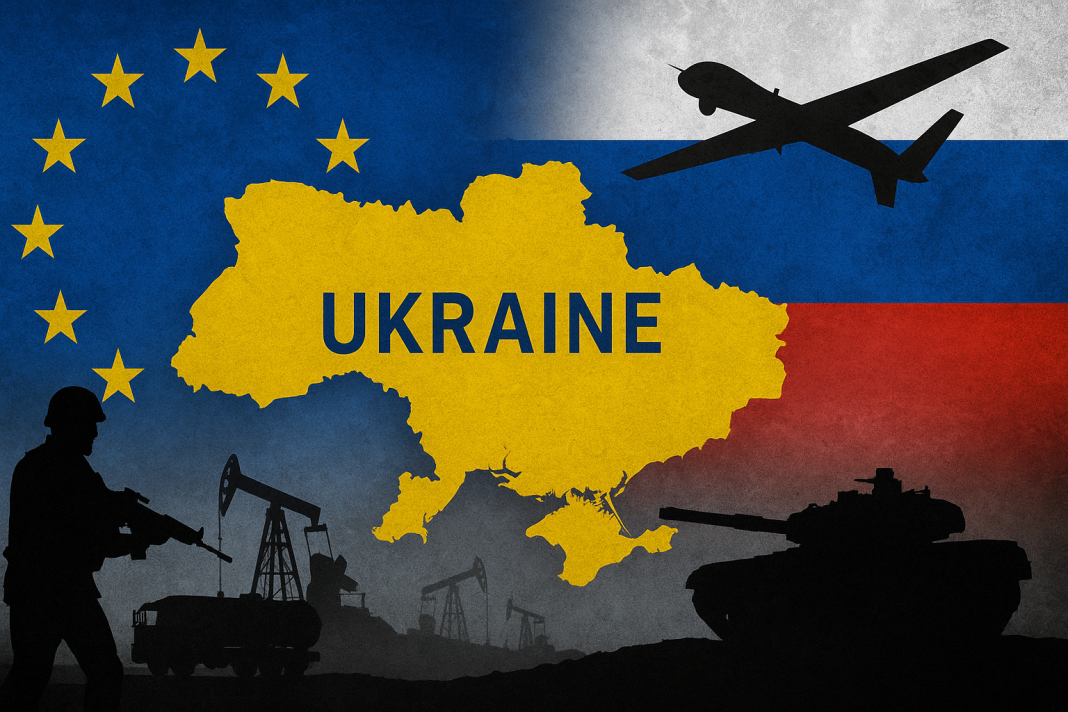Ukraine has escalated its campaign to weaken Russia’s war finances while simultaneously defending against a massive assault in the Pokrovsk battle. President Volodymyr Zelensky, joined by Foreign Minister Andrii Sybiha and Security Service head Vasyl Malyuk, announced that Ukraine has launched eleven coordinated sanction packages this year. These measures directly target and choke the financial lifelines funding Russia’s ongoing aggression — including the forces fighting in Pokrovsk — and Ukraine has synchronized them with the European Union, the United States, Canada, and the United Kingdom.
Ukraine’s Sanction Offensive and the Pokrovsk Battle Connection
Zelensky stated that Ukraine coordinated with the EU to develop six of these sanction packages and will complete the next phase in the coming month. The Ukrainian government believes that reducing Russia’s income will directly limit its ability to maintain large-scale offensives like the Pokrovsk battle, where heavy fighting continues every day.
Ukraine has also strengthened its engagement with the G7 nations — particularly Canada, Australia, the UK, Japan, and EU member states — to enforce stricter controls on Russian energy exports. These coordinated actions aim to dry up Moscow’s oil revenues, which finance nearly 90% of its military budget. Zelensky noted that while these allied countries have reduced or stopped imports from Russia, others like India, China, Turkey, and parts of Central Asia have expanded trade with Moscow, indirectly supporting the war.
Russia deploys 9M729 missile in Ukraine conflict as analysts warn of wider European security risks
According to Zelensky, the new U.S. sanctions expected to take effect around November 20, 2025, could cause Russia to lose approximately 50 billion U.S. dollars in one year. International experts predict that the broader economic impact could reach up to 120 billion dollars, severely damaging Russia’s budget — the same budget used to sustain the Pokrovsk battle and similar military campaigns.
These sanctions, Zelensky emphasized, are vital for undermining Russia’s capacity to produce and transport weapons to frontlines, especially in areas like Pokrovsk, where intense clashes demand a constant flow of supplies and ammunition.
Strikes, Sanctions, and the Hidden Fronts Behind the Battle
Beyond financial pressure, Ukraine is striking directly at Russia’s industrial and military infrastructure through what Zelensky calls “kinetic sanctions.” Ukraine conducts targeted military operations to disrupt oil production, supply lines, and ammunition depots that fuel battles such as the Pokrovsk battle.
Ukrainian forces often carry out these high-precision operations deep within Russian territory — sometimes more than 120 kilometers behind enemy lines. Zelensky revealed that since early 2025, Ukraine has destroyed nearly 48% of Russia’s total shell reserves, significantly reducing Moscow’s ability to support attacks like those occurring in Pokrovsk.
Fueling the frontlines — Ukraine’s drone assaults cripple 20% of Russia’s oil capacity
Ukraine’s Defense Forces, together with the Security Service (SBU) and the Main Intelligence Directorate (GUR), coordinate these missions under full presidential authorization. In one such mission, Ukrainian forces completely destroyed the Russian “Oreshnik” facility, a vital asset that supported the Russian war effort. They kept the operation secret at the time but later confirmed it as a 100% success.
Ukraine also developed a strategy linking its kinetic actions to economic sanctions. When Ukrainian strikes damage Russian infrastructure, Moscow must repair the facilities using imported components — many of which Western sanctions already restrict.
This combined pressure weakens Russia’s supply networks and hinders its ability to reinforce fronts like the Pokrovsk battle. Officials highlighted that Ukraine has enforced more than 50 individual sanctions under presidential decrees, marking the fastest pace of enforcement globally. This aggressive approach demonstrates Ukraine’s determination to apply both financial and physical pressure against Russia, from its oil refineries to its battlefield operations, including those surrounding Pokrovsk.
Zelensky’s Defiance as the Pokrovsk Battle Rages On
While Ukraine strikes Russian assets from afar, the Pokrovsk battle remains one of the fiercest and most critical confrontations inside Ukraine. Zelensky described the situation as “extremely difficult,” warning against believing false Russian narratives about territorial gains. He revealed that nearly 170,000 Russian troops are concentrated near Pokrovsk, underscoring how important the city has become for Moscow’s military objectives.
Zelensky stated that Russian forces had previously failed to capture Sievierodonetsk and Kupiansk, pushing them to focus their efforts on Pokrovsk as a symbolic target. However, despite Russia’s large troop presence and constant bombardments, Ukrainian soldiers have maintained control over their defensive lines. According to Zelensky, Ukrainian forces have reached a nearby river, cutting off Russian movements and making it almost impossible for enemy units to cross.
Zelensky emphasized that Ukrainian troops are steadily defeating Russian forces in Pokrovsk, one position at a time, asserting that Moscow’s attempts to claim victory have already failed. He noted that while the Zaporizhzhia and Dovhlyia fronts are stabilizing, Pokrovsk remains the center of heavy fighting.
Mocking Putin’s claim of visiting Pokrovsk, Zelensky said Ukrainian forces would be “waiting for him,” reflecting Ukraine’s resolve to defend its cities despite relentless air and ground attacks.
As sanctions tighten and Ukrainian drones strike key Russian infrastructure, the Pokrovsk battle has become a symbol of Ukraine’s broader fight for survival and sovereignty — where economic pressure and military resistance converge.

